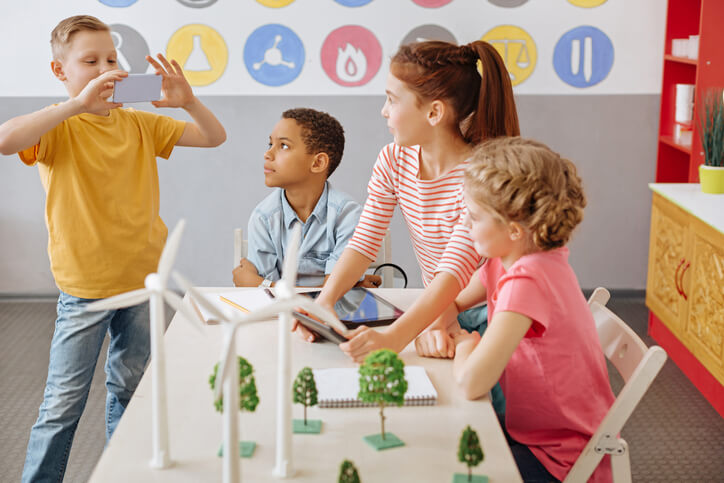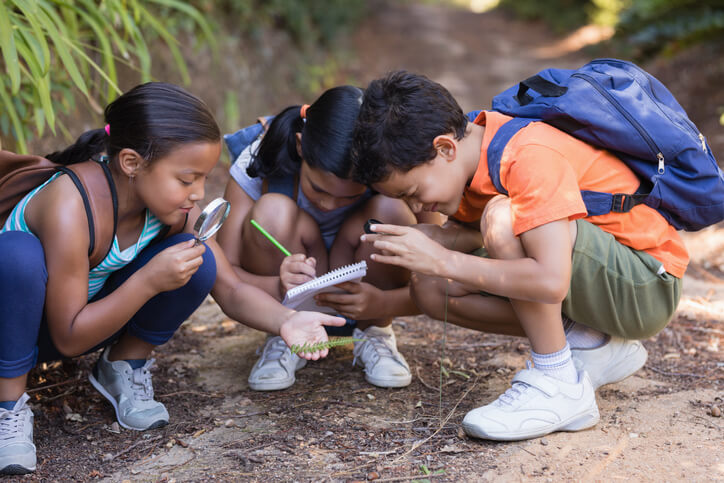Published on January 18th, 2023
What is differentiated instruction?
10 minute read

Differentiated instruction is a way for teachers to address various learning types and capabilities in the classroom.
In the past, if a student wasn’t able to process a lesson, it was often seen as a personal failure. In addition to being discouraging, this meant the student had to put in more work than some of their peers if they wanted to achieve a similar measure of academic success.
Today, educators understand that students learn in different ways. They recognize each learner’s unique challenges and strengths, and in encouraging these differences, they inspire confidence among their students.
Educators have made tremendous strides, but that does not mean that creating a tailored approach is an easy feat. Luckily, Promethean is here to help you connect the dots and tailor lessons to any learning style in any student.
Keep reading to learn more about differentiated learning, what it entails, and how to take the next generation to the next level with Promethean smart panels, software, and more.
Goal: Maximize learning for all students
Differentiated instruction is not one rule applied to any given classroom; it’s a framework. It lets educators adopt and deploy a collection of teaching strategies. The intended result is to give each student as many opportunities as possible to succeed.
It is also the best way to see better classwide results. The one-size-fits-all instruction of the past might make each student’s strengths and weaknesses apparent, but it doesn’t speak to the quality of the instruction.
By looking to maximize the opportunity each individual student has for success, differentiated learning maximizes the learning potential of the class as a whole.
The four elements of differentiated instruction
There are four key elements of every classroom that factor into a lesson’s efficacy – content, process, products, and environment.
Teachers adjusting their lesson plans to create the strategies that add up to differentiated learning should familiarize themselves with these distinctions. This way, they can better adapt the various elements of their classroom to the unique needs of their learners.
Content
Content refers to the material or topic of the lesson. Conceptually, we can break this down into two parts:
- The information the student needs to learn.
- How the student can gain access to the information.
A savvy educator can differentiate their classroom content in several practical ways:
- Assigning reading passages that vary based on that student’s reading level. This way, students of other learning styles do not have to struggle or rush through the assignment.
- Use software like Promethean’s ActivInspire to record lessons visually and auditorily. This gives an auditory or visual learner the same chance of success as a read/write learner.
- Pairing students with similar or complementary learning styles on the same project. It may promote more equitable contributions across all group members.
- Using small group sessions to reiterate lessons or give students exposure to the learning styles of their peers. Students who are uncertain about the material have a chance to review it or see it from new perspectives without having to admit they’re struggling.
Process
The process of a lesson refers to the activities students will engage in.
A student’s interest refers to their curiosity about a particular subject. A student who is interested in a topic is more likely to be motivated and engaged with the lesson.

Readiness refers to a student’s ability and aptitude for a subject.
Designing a variety of differentiated classroom procedures based on the interest and readiness of students leads to improved learning outcomes.
- Tiered activities like character maps allow students of any readiness level to engage with new content and material. They also get the necessary support and structure they need to overcome their challenges.
- Creating interest centers where students can further their knowledge of topics that they show genuine curiosity for. For example, a student who loves animals becomes more interested in geography lessons when they can explore the local wildlife.
- Having each student develop their own personalized goal sheet doesn’t just clarify their intentions, it tells the teacher what they need to know. Educators can use these agendas as a framework for motivating students and keeping them on task.
- Offer opportunities for students to leave their seats and engage hands-on with the lesson. This is especially beneficial to kinesthetic learners. The tactile or hands-on support for students that learn better through action can make a massive difference.
Products
The culmination of a lesson is referred to as the product.
A product is the end result of engagement in a lesson. It can vary from things like achieving a particular learning outcome to the creation of something tangible, like a model or diagram.
- Give your students options for how they turn in their assignments to allow for creative expression. Some students might enjoy giving their own presentation on the interactive display, while others might like filming a tutorial or performing a skit.
- Use clearly defined rubrics to evaluate students along the lines of their differentiated skills and their respective readiness levels. This helps students focus and make progress on areas where they could improve with less confusion.
- Allow students to choose between working in small groups with their peers or working alone. Solitary learners won’t feel burdened while others will feel less bored or more confident by making it a team effort.
- Empower students to define their end goals for a product assignment – assuming the finished product contains all required learning elements, of course.
Environment
The fourth and final element of differentiated instruction is the environment, the physical space in which students learn. This is also the intangible mood or feelings associated with classroom function.
An environment does not refer exclusively to the chairs and desks where students are seated. The environment encapsulates how comfortable students feel, the attitude and teaching style of the educator, and what it all contributes to the learning experience.
- Ensure there are spaces where students can work quietly and free from distraction, as well as spaces where students can congregate and work openly with their peers. Good examples of this would be study or reading corners for solitary work and larger tables for group collaborations.
- Design your classroom to reflect a breadth of cultures and home settings. This applies to the material as well, as representation makes students feel as though they belong.
- Use Classflow to deliver instruction simultaneously to in-person and at-home students, making remote learning feel less isolating.
- Create lesson plans that can be adapted to fit the needs of the individual.
- Give students the freedom to work on assignments at their own pace, or in settings that are preferable to them.
- Teach students about the different kinds of learners, so that they understand the value of taking part in differentiated learning exercises. This fosters respect and understanding among students.
- Develop a collaborative environment that encourages students to help their peers when teachers are busy and cannot immediately address them. This is supported by their understanding of their peers’ learning styles.
Promethean supports differentiated learning
When it comes to lesson planning, Promethean’s lineup of products and essential apps provides educators with endless opportunities for differentiation.
Using educational technology like smart panels, educators can effectively create a breadth of instructional activities meant to give every student their best chance at academic success.
Request a live demo of the Promethean ActivPanel to see how interactive displays can support any type of learner.




